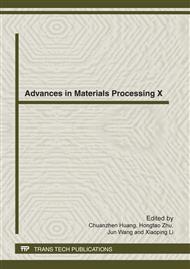[1]
X.L. Liu: Polycrystalline Cubic Boron Nitride Cutting tools and application [M]. Heilongjiang Science and Technology Publishing House, (1999), pp.20-50. (In Chinese).
Google Scholar
[2]
M.H. Xiao, N. He, L. Li and H.B. Liu: Experimental studies on notch wear for high speed machining of nickel2based super alloy with ceramic tools [J]. China Mechanical Engineering, Vol. 19 (2008), No. 10, pp.1188-1192. (In Chinese).
Google Scholar
[3]
L.H. Xu, Z.F. Jiang and Jan-Eric Stahl: Research on the influence of carbon content on the machinability of Inconel 718 [J]. Modern Manufacturing Engineering. Vol. 2 (2010), pp.91-94. (In Chinese).
Google Scholar
[4]
Thakur, D. G., B. Ramamoorthy and Vijayaraghavan, L: Machinability investigation of Inconel 718 in high-speed turning., The International Journal of Advanced Manufacturing Technology, Vol. 45 (2009), pp.421-429.
DOI: 10.1007/s00170-009-1987-x
Google Scholar
[5]
C. Liu, X. Ai, Z. Q. Liu and Y. Wan: Wear mechanism of cemented carbide tool in High Speed Machining Iron-based superalloy GH2132 [J]. Transactions of the Chinese Society for Agricultural Machinery. Vol. 40 (2009) No. 11, pp.240-244. (In Chinese).
Google Scholar
[6]
D.L. Wang, Z. F. Xun, J.Y. Pang and A.Y. Sun: An investigation of the machinability of K24 nickel-based super alloy [J] . Chinese Journal of Mechanical Engineering, Vol. 38 (2002) No. 12, pp.19-193. (In Chinese).
DOI: 10.3901/jme.2002.supp.190
Google Scholar
[7]
Arunachalam R, Mannan MA: Machinability of nickel-based high temperature alloys [J]. Mach Sci Technol, Vol. 4 (2000) No. 1, pp.127-168.
Google Scholar
[8]
Ezugwu EO, Bonney J and Yamane Y: An overview of the machinability of aeroengine alloys [J]. J Mater Process Technol, Vol. 134 (2003) No. 2 pp.233-253.
DOI: 10.1016/s0924-0136(02)01042-7
Google Scholar
[9]
Pawade RS, Suhas S, Joshi S, Brahmankar PK and Rahman M. An investigation of cutting forces and surface damage in high-speed turning of Inconel718 [J]. J Mater Process Technol. ,Vol. 192-193 (2007), pp.139-146.
DOI: 10.1016/j.jmatprotec.2007.04.049
Google Scholar
[10]
Sharman ARC, Amarasinghe A, Ridgway K: Tool life and surface integrity aspects when drilling and hole making in Inconel718 [J]. J Mater Process, 2008, 200(1): 424 - 432.
DOI: 10.1016/j.jmatprotec.2007.08.080
Google Scholar
[11]
Costes JP, Guillet Y, Poulachon G and Dessoly M: Tool-life and wear mechanisms of CBN tools in machining of Inconel 718. International Journal of Machine Tools and Manufacture, Vol. 47 (2007), pp.1081-1087.
DOI: 10.1016/j.ijmachtools.2006.09.031
Google Scholar


